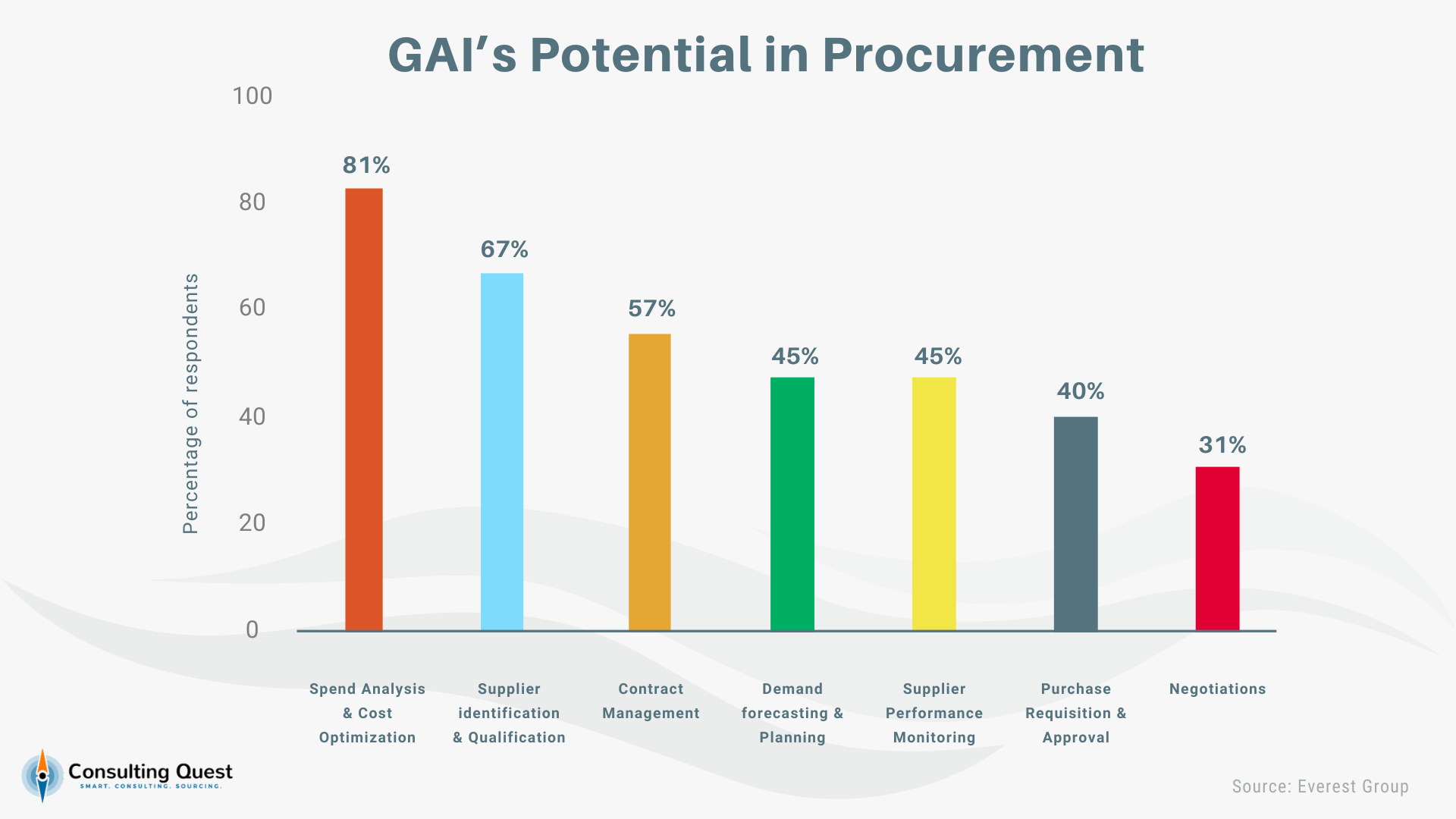Table of Contents
Generative AI in procurement is rapidly becoming a game-changer in how we approach business processes. As our world is buzzing with exciting changes in this arena, the realm of procurement is also catching fire.
I was diving into some eye-opening research – the Avasant Procurement Business Process Transformation 2023 RadarView report – and it revealed how Artificial Intelligence (AI) and Machine Learning (ML) are becoming the new stars in the procurement show in sourcing, managing and sustaining businesses.
Over 55% of the procurement business process transformation engagements now involve the adoption of digital procurement tools and platforms, and over 40% of procurement engagements involve the adoption of AI and ML capabilities, according to this report.
Generative AI tools such as ChatGPT and Bard are all set to accelerate this momentum by leaps and bounds. In this article, I intend to have a heart-to-heart about the transformative capabilities of Generative AI in procurement, especially indirect, exploring its applications, advantages, and the critical imperative of safeguarding data privacy in an era where knowledge and trust are valued in gold.
How’s Procurement Getting Smarter With GAI?
In essence, GAI injects automation and intelligence into conventional procurement methods, resulting in streamlined processes and enhanced decision-making.
Amidst escalating supply chain disruptions, Chief Procurement Officers (CPOs) at CPS face a crucial mission: to enhance control, boost visibility, enforce policy adherence, and minimize process errors.
Concurrently, on the talent management front, there’s a pressing need for personalized skill development programs tailored to each employee to address skill deficiencies effectively. Generative AI emerges as a strategic tool in meeting these challenges head-on, offering solutions in several key areas:
Now, let’s delve into the precise applications of GAI in procurement and resulting benefits:
Process Automation
Imagine having an efficient assistant to handle the boring stuff, like purchase order creation, invoice processing, and contract management. You can leverage Generative AI exactly in the same way to take care of your repetitive tasks. It will free up your time for the important, strategic tasks.
Insights and Decision Support
Generative AI can scrape out valuable information from internal and external data sources in a jiffy. As procurement professionals that will provide you with easy-to-digest insights to support your decision-making processes
Textual Data Analysis
Both direct and indirect procurement involves handling vast amounts of data from various sources. Sorting through this data manually can be overwhelming, leading to delays and decision-making errors.
GAI-powered solutions can not only swiftly analyze and categorize massive datasets, but can also extract relevant insights and trends at the same time. All these prove to be particularly helpful for tasks such as vendor evaluation, compliance monitoring, and contract analysis.
Supplier Relationships
Managing relationships with suppliers involve keeping with unique terms, conditions, and performance metrics for each. Keeping track of these details manually is time-consuming and prone to oversight.
AI Solution, when applied to procurement, can streamline supplier relationship management by evaluating supplier risks, by spotting potential disruptions and proposing contingency plans and more. Thus, GAI can aid businesses in minimizing vulnerabilities while fortifying the resilience of the supply chain.
For instance, Generative AI Solution, when applied to consulting services procurement, can organize and analyze complex data specific to consulting engagements, helping clients to identify patterns and areas for improvement. This empowers clients to negotiate better terms in consulting contracts, and ensure compliance.
Streamlining Document Management
Crafting and handling procurement documents, such as contracts, requests for proposal (RFPs), and purchase orders, demands a significant investment of time and meticulous attention.
Enter Generative AI (GAI) tools, designed to automate the creation of procurement documents, ensuring impeccable accuracy and consistency. How? These tools handle routine tasks, like drafting RFPs or contracts, liberating professionals to concentrate on the more strategic aspects of the procurement process.
For instance, our consource solution incorporates an AI-powered RFP wizard, specifically crafted to simplify the creation of RFI or RFP documents. Clearly define your strategic priorities and expected outcomes, outlining your aspirations and areas of investment. Our AI-powered RFP wizard seamlessly translates your vision into an RFP, facilitating the identification of the most suitable consultants for your project.
Spend Management
Understanding and managing indirect spend across diverse categories can be challenging. Procurement professionals often struggle to gain comprehensive visibility into spending patterns and identify areas for cost optimization.
AI analytics can provide real-time insights into spending patterns, vendor performance, and potential cost-saving opportunities. All these insights empower professionals to make data-driven decisions, optimize costs, and drive overall efficiency in indirect procurement.
We can’t help but mention consource once again, using it as an example of how AI can make the life of consulting procurement executives a little easier. This AI-powered digital procurement solution enables you to take an ROI-focused approach to defining your strategic priorities and expected consulting budget cycle. Segment and refine your budget allocations, maximize your return on investment, and align your spend with your strategic priorities.
Here I recommend a valuable resource from our Insight library to enhance your understanding of this subject. Read here.
Compliance Management and Organizational Governance
In the current business environment, characterized by rapidly evolving regulations and increasing demands for transparency and ethical conduct, the role of compliance management in procurement has never been more critical.
Organizations face the dual challenge of ensuring adherence to legal standards and maintaining operational efficiency. This is where Generative AI becomes not just a technological asset but a strategic necessity.
Let’s take a look at the broad spectrum of benefits that Generative AI can offer in Organizational Governance:
Enhanced Policy Adherence and Correction Measures: By thoroughly analyzing policy documents and compliance reports, Generative AI assists in identifying lapses and enforcing adherence to set standards. This ensures that organizational processes align consistently with established policies.
Promoting Ethical and Sustainable Practices: Generative AI’s role extends beyond compliance to fostering ethical practices within procurement. By promoting transparency and accountability, it helps build a culture of integrity, which is increasingly important to stakeholders and consumers alike.
Building Trust and Ensuring Responsibility: In the age of information, stakeholders from customers to investors are more conscious of organizational practices. Generative AI aids in maintaining practices that meet legal and ethical standards, thereby enhancing stakeholder trust and supporting responsible procurement.
| For some additional insights into this subject, we recommend checking out one of our previous Procurement Game Changer podcasts, Generative AI in procurement, where we explore several aspects of the implications and applications of Generative AI in procurement in general. |
Understanding Generative AI Constraints: Implications for Procurement
It is beyond any debate that generative AI holds tremendous promise of revolutionary changes for the field of procurement.
However, the very capabilities that make generative AI a potential game-changer also introduce ethical and privacy challenges, notably with regard to privacy and confidentiality. These challenges stem from inherent limitations within the technology.
Before examining these privacy issues, let us quickly take a look at its limitations.
- Generative AI’s prowess hinges on the quality and diversity of its training data. Inadequate or subpar training data can lead to outputs that are inaccurate or constrained, undermining the very essence of the technology’s potential.
- The impressive capabilities of generative AI come at a cost—significant computational power. This reliance makes the technology both expensive and time-consuming, posing challenges for organizations looking to adopt it on a broad scale.
- While the allure of generative AI lies in its ability to generate contextually relevant outputs, its outputs can be inconsistent and inaccurate. This inconsistency challenges the reliability and predictability that are crucial in the intricate landscape of procurement.
- The utilization of generative AI tools crops up a plethora of ethical considerations, namely copyright infringement and the inadvertent disclosure of sensitive information. It often raises questions organizational integrity and legal standing.
- Generative AI tools, for all their sophistication, are not without bounds. They operate within a defined scope, and the risk of confabulation—producing unexpected or undesired outputs—adds an additional layer of complexity to their deployment. Understanding and mitigating this risk becomes paramount for organizations seeking to leverage generative AI in procurement.
Exploring Privacy Risks: Generative AI in Procurement
One of the foremost privacy concerns stems from the inadvertent generation of content that may violate individuals’ personal information. Generative AI models learn from training data, often sourced from multiple channels without explicit consent, making them susceptible to privacy risks and potential security breaches.
Now, in the realm of consulting, where confidentiality is our middle name, this poses a significant risk. We’re not just talking about accidentally sharing tidbits; we’re talking about potential damage to client relationships, reputations, and the sacred trust we’ve built.
For generative AI tools like ChatGPT, concerns arise regarding the inclusion of user data in the training set. The collection of user prompts and other data raises red flags, demanding careful consideration when working with private, sensitive, or identifiable information in procurement processes.
The sharing of information used to train AI tools depends on organizational policies, data privacy regulations, and the nature of the training data. While some organizations may disclose their use of public data, the proprietary nature of the training dataset and methods underscores the need for caution.
This lack of transparency raises the risk that prompts containing sensitive information in RFPs could be inadvertently used and disseminated, particularly concerning in the consulting services sector where confidentiality is paramount.
Therefore, the intersection of generative AI and procurement, especially in sensitive domains like consulting services, demands a thoughtful approach to mitigate privacy concerns. Striking a balance between leveraging the capabilities of generative AI and safeguarding sensitive information is imperative to ensure ethical, legal, and responsible use in the ever-evolving landscape of procurement practices.
Embarking on A-Driven Transformation – Factors to Consider
Selecting the Right AI Solutions
In the crowded world of AI technologies, making the right choice is paramount. It’s not just about picking any AI tool; it’s about finding the one that fits your specific business challenges and aligns perfectly with your organizational goals.
This strategic alignment is crucial. It ensures that decision-making is streamlined and effective, avoiding the pitfalls of adding complex systems that don’t really serve your unique needs.
Defining Procurement’s Role in the AI Era
It’s essential to determine the future role of procurement in your organization. Will it be an “efficient machine” primarily focused on maximizing process efficiency, where technology plays a leading role?
Or, will it evolve into a “value generator,” driving new objectives and embracing roles in relationship management, innovation, sustainability, and enhancing supply chain effectiveness? This decision will shape the direction of AI integration in procurement functions.
Transforming and Upskilling Your Workforce
As Chief Procurement Officers (CPOs) navigate this shift, they must also transform their teams. This transformation isn’t just about employing new technology; it’s about empowering people. It involves a mix of retraining existing staff and bringing in fresh talent proficient in areas like large language model deployment, prompt engineering, and data science. The goal is to blend traditional procurement skills with new, AI-driven capabilities.
Enhancing Relationship Management
In the age of AI, procurement shouldn’t lose sight of the human element – particularly in relationship management. This involves strengthening internal collaborations with various business units, ensuring that procurement strategies are aligned with overall business objectives.
Externally, it means deepening engagement with key suppliers. By leveraging AI, procurement can uncover new opportunities for collaboration and value creation, both within and outside the organization.
Implementing Holistically and Managing Change
Finally, integrating AI into procurement is more than just a technological upgrade; it’s a holistic transformation. This means considering how the organization needs to adapt, managing the change process carefully, and building the necessary capabilities.
Given that a significant number of executives feel unprepared for such transformations, particularly in addressing skill gaps, prioritizing workforce education and aligning incentives with new objectives is critical. This comprehensive approach ensures that AI integration delivers its full potential, transforming procurement into a more efficient, innovative, and value-driven function.
Conclusion: Fast Forward to the Future of Procurement with GAI
As GenAI gets really good at handling the usual tasks, we’ll need fewer hands-on deck for the regular procurement stuff, shaking up how we do things. You know, categories like project management, sourcing, and all the negotiations? They’re in for a makeover, and even supporting activities like spend analysis and contract management will get a facelift.
Now, if we jump into this GenAI world with both feet, Chief Procurement Officers can be wizards of efficiency, achieving top-notch outcomes with way fewer resources—somewhere between 50-75% less.
But here’s the catch, as we step into this AI-powered realm, we’ve got a big responsibility on our hands: keeping our data safe and cozy. Privacy standards and following the rules are non-negotiable. It’s what guides us in picking the right GenAI solutions.
And here’s the million-dollar question: Can cozying up to AI help procurement become a strategic powerhouse, a real value generator? Well, that’s the journey we’re on, and it’s exciting to see where embracing AI will take us in steering the ship toward strategic success.







